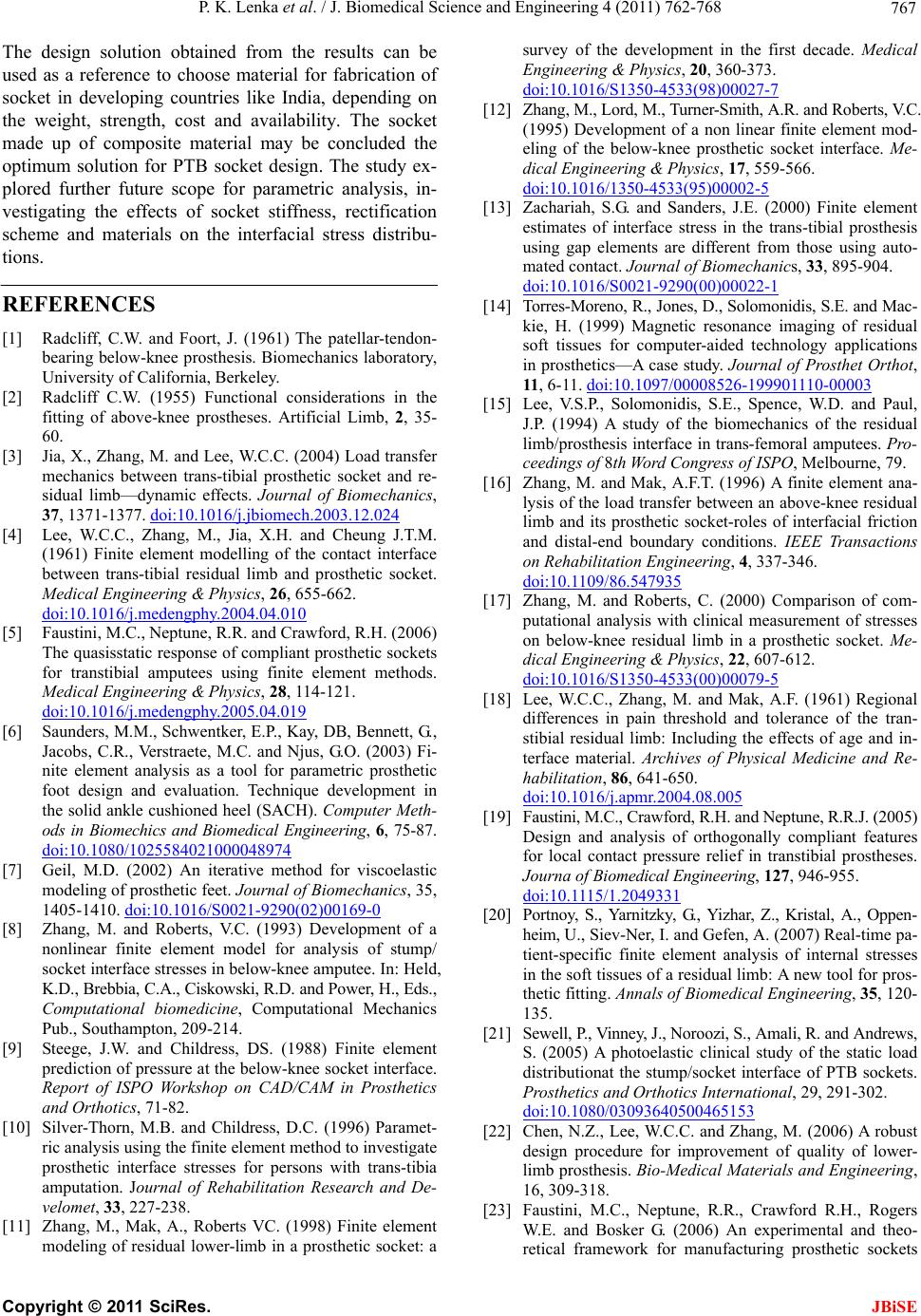
P. K. Lenka et al. / J. Biomedical Science and Engineering 4 (2011) 762-768 767
The design solution obtained from the results can be
used as a reference to choose material for fabrication of
socket in developing countries like India, depending on
the weight, strength, cost and availability. The socket
made up of composite material may be concluded the
optimum solution for PTB socket design. The study ex-
plored further future scope for parametric analysis, in-
vestigating the effects of socket stiffness, rectification
scheme and materials on the interfacial stress distribu-
tions.
REFERENCES
[1] Radcliff, C.W. and Foort, J. (1961) The patellar-tendon-
bearing below-knee prosthesis. Biomechanics laboratory,
University of California, Berkeley.
[2] Radcliff C.W. (1955) Functional considerations in the
fitting of above-knee prostheses. Artificial Limb, 2, 35-
60.
[3] Jia, X., Zhang, M. and Lee, W.C.C. (2004) Load transfer
mechanics between trans-tibial prosthetic socket and re-
sidual limb—dynamic effects. Journal of Biomechanics,
37, 1371-1377. doi:10.1016/j.jbiomech.2003.12.024
[4] Lee, W.C.C., Zhang, M., Jia, X.H. and Cheung J.T.M.
(1961) Finite element modelling of the contact interface
between trans-tibial residual limb and prosthetic socket.
Medical Engineering & Physics, 26, 655-662.
doi:10.1016/j.medengphy.2004.04.010
[5] Faustini, M.C., Neptune, R.R. and Crawford, R.H. (2006)
The quasisstatic response of compliant prosthetic sockets
for transtibial amputees using finite element methods.
Medical Engineering & Physics, 28, 114-121.
doi:10.1016/j.medengphy.2005.04.019
[6] Saunders, M.M., Schwentker, E.P., Kay, DB, Bennett, G. ,
Jacobs, C.R., Verstraete, M.C. and Njus, G.O. (2003) Fi-
nite element analysis as a tool for parametric prosthetic
foot design and evaluation. Technique development in
the solid ankle cushioned heel (SACH). Computer Meth-
ods in Biomechics and Biomedical Engineering, 6, 75-87.
doi:10.1080/1025584021000048974
[7] Geil, M.D. (2002) An iterative method for viscoelastic
modeling of prosthetic feet. Journal of Biomechanics, 35,
1405-1410. doi:10.1016/S0021-9290(02)00169-0
[8] Zhang, M. and Roberts, V.C. (1993) Development of a
nonlinear finite element model for analysis of stump/
socket interface stresses in below-knee amputee. In: Held,
K.D., Brebbia, C.A. , Ciskow ski, R.D. and Po wer, H., Eds.,
Computational biomedicine, Computational Mechanics
Pub., Southampton, 209-214.
[9] Steege, J.W. and Childress, DS. (1988) Finite element
prediction of pressure at the below-knee socket interface.
Report of ISPO Workshop on CAD/CAM in Prosthetics
and Orthotics, 71-82.
[10] Silver-Thorn, M.B. and Childress, D.C. (1996) Paramet-
ric analysis using the finite element method to investigate
prosthetic interface stresses for persons with trans-tibia
amputation. Journal of Rehabilitation Research and De-
velomet, 33, 227-238.
[11] Zhang, M., Mak, A., Roberts VC. (1998) Finite element
modeling of residual lower-limb in a prosthetic socket: a
survey of the development in the first decade. Medical
Engineering & Physics, 20, 360-373.
doi:10.1016/S1350-4533(98)00027-7
[12] Zhang, M., Lord, M., Turner-Smith, A.R. and Roberts, V.C.
(1995) Development of a non linear finite element mod-
eling of the below-knee prosthetic socket interface. Me-
dical Engineering & Physics, 17, 559-566.
doi:10.1016/1350-4533(95)00002-5
[13] Zachariah, S.G. and Sanders, J.E. (2000) Finite element
estimates of interface stress in the trans-tibial prosthesis
using gap elements are different from those using auto-
mated contact. Journal of Biomechanics, 33, 895-904.
doi:10.1016/S0021-9290(00)00022-1
[14] Torres- Moreno, R., Jones, D., Solomonidis, S.E. and Mac-
kie, H. (1999) Magnetic resonance imaging of residual
soft tissues for computer-aided technology applications
in prosthetics—A case study. Journal of Prosthet Orthot,
11, 6-11. doi:10.1097/00008526-199901110-00003
[15] Lee, V.S.P., Solomonidis, S.E., Spence, W.D. and Paul,
J.P. (1994) A study of the biomechanics of the residual
limb/prosthesis interface in trans-femoral amputees. Pro-
ceedings of 8th Word Congress of ISPO, Melbourne, 79.
[16] Zhang, M. and Mak, A.F.T. (1996) A finite element ana-
lysis of the load transfer between an above-knee residual
limb and its prosthetic socket-roles of interfacial friction
and distal-end boundary conditions. IEEE Transactions
on Rehabilitation Engineering, 4, 337-346.
doi:10.1109/86.547935
[17] Zhang, M. and Roberts, C. (2000) Comparison of com-
putational analysis with clinical measurement of stresses
on below-knee residual limb in a prosthetic socket. Me-
dical Engineering & Physics, 22, 607-612.
doi:10.1016/S1350-4533(00)00079-5
[18] Lee, W.C.C., Zhang, M. and Mak, A.F. (1961) Regional
differences in pain threshold and tolerance of the tran-
stibial residual limb: Including the effects of age and in-
terface material. Archives of Physical Medicine and Re-
habilitation, 86, 641-650.
doi:10.1016/j.apmr.2004.08.005
[19] Faustini, M.C., Crawford, R.H. and Neptune, R.R.J. (2005)
Design and analysis of orthogonally compliant features
for local contact pressure relief in transtibial prostheses.
Journa of Biomedical Engineering, 127, 946-955.
doi:10.1115/1.2049331
[20] Portnoy, S., Yarnitzky, G., Yizhar, Z., Kristal, A., Oppen-
heim, U., Siev-Ner, I. and Gefen, A. (2007) Real-time pa-
tient-specific finite element analysis of internal stresses
in the soft tissues of a residual limb: A new tool for pros-
thetic fitting. Annals of Biomedical Engineering, 35, 120-
135.
[21] Sewell, P., Vinney, J., Noroozi, S., Amali, R. and Andrews,
S. (2005) A photoelastic clinical study of the static load
distributionat the stump/socket interface of PTB sockets.
Prosthetics and Orthotics International, 29, 291-302.
doi:10.1080/03093640500465153
[22] Chen, N.Z., Lee, W.C.C. and Zhang, M. (2006) A robust
design procedure for improvement of quality of lower-
limb prosthesis. Bio-Medical Materials and Engineering,
16, 309-318.
[23] Faustini, M.C., Neptune, R.R., Crawford R.H., Rogers
W.E. and Bosker G. (2006) An experimental and theo-
retical framework for manufacturing prosthetic sockets
C
opyright © 2011 SciRes. JBiSE